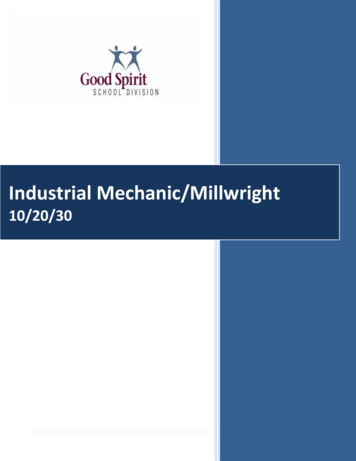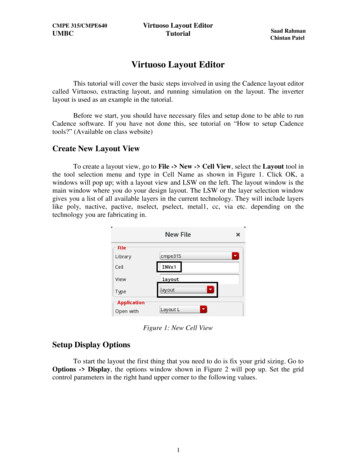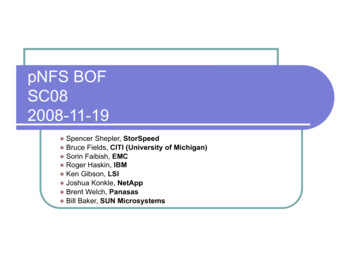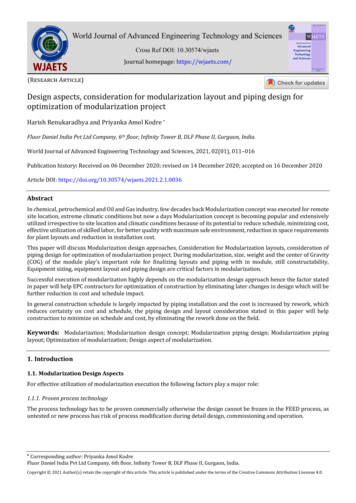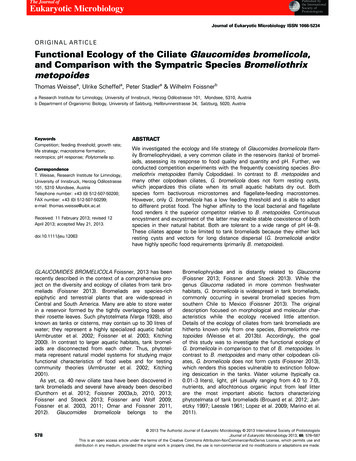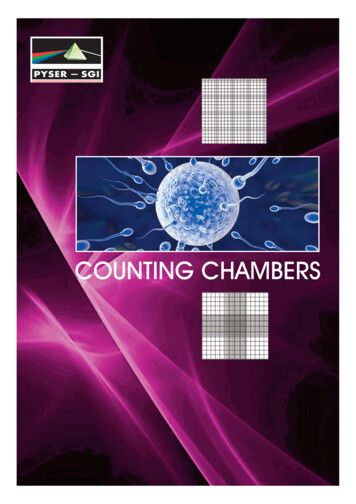
Transcription
COUNTING CHAMBERS
COUNTING CHAMBERSAs well as an extensive selection of specialist chambers for Haemocytometry,Parasitology and Cytology. The range includes:Pyser-SGI Counting Chambers.The Pyser-SGI grid-marked Sedgewick Rafter counting chamber. Available in both plastic anddurable glass versions, excellent for determining counts in known volumes of sample evenusing zoom stereo microscopes.The Pyser-SGI Howard Cell for spore counting in tomato and fruit juice.The MAKLER Semen Counting Chamber.n Sedgewick Rafter Celln Howard Celln Makler Chambern Specialist ChambersSedgewick-Rafter Chamber2Pages 3-5Pages 6-7Pages 8Pages 9-17Howard Counting Cell
SEDGEWICK RAFTER CELLThe Pyser-SGI S50 & S52 Sedgewick Rafter counting cells are used widely in water analysis, cultureinspection and for other applications where particles per unit volume in fluid must be determined.Pyser-SGI’s Sedgewick-Rafters are available in glass and plastic versions. The glass cell is designed forrepeated cleaning and re-use, whereas the plastic version is designed for either a single or finite use only.Each chamber is supplied with one type S51 cover glass.The Sedgewick-Rafter Chambers consists of a 2mm thick clear base slide (76 x 40 mm), onto which has beenbuilt a rectangular chamber. On to the top of this chamber is placed a cover slip.This chamber is 50mm long x 20mm wide and 1mm deep and its base is marked with a grid of one thousand1mm squares. When filled with liquid and with a cover glass placed over the chamber, a 1ml volume of liquid istrapped.When used under a low magnification light microscope, each of the grid squares equates to 1microlitre (μl) ofliquid.S50 - Plastic Sedgewick Rafter Counting ChamberPatternS50DescriptionOrder codeSedgewick Rafter Counting Chamber[plastic] Includes 1 cover glass02C00415Key FeaturesPlastic - economically priced cellDescriptionAn economically priced cell, for one time (or possibly several time) use and for educational/trainingexercises.Generally we do not recommended the S50 plastic version for the professional user. The softness ofthe plastic means it is easily scratched and otherwise damaged. However most laboratories who douse the plastic version see it more as a "throw away" or consumable, which may best suit certainapplications.3
S52 - Glass Sedgewick Rafter Counting ChamberPatternS52DescriptionOrder codeSedgewick Rafter Counting Chamber[Glass] Includes 1 cover glass02B00417Key FeaturesGlass - Professional CellDescriptionA serious reusable tool for the professional user. The cell is made of high quality optical glass with achromium surface image. It is intended for continued professional use and whenever using phasecontrast.S51 - Spare Coverglass for Pyser-SGI Sedgewick Rafter Counting ChamberPatternS51DescriptionOrder codeCover glass for use with bothGlass & Plastic Cells02C00416Key FeaturesFor use with both Glass & Plastic CellsDescriptionBoth Pyser-SGI Plastic and Glass Sedgewick Rafter Cells are supplied with a cover glass. Additionalspare cover glasses are available to order from stock, as this S514
Sedgewick-Rafter Filling Method & UsageThe cell can be used with either living or preserved material. To fill the cell, place the cover glass across thechamber top (Fig A). This allows the air bubbles to escape during the filling procedure. The sample is thentaken into a 1ml wide mouthed pipette and then carefully transferred to the chamber.Do not overfill the chamber, because the volume of the sample in the chamber must be known exactly and thecover glass must not float free, but held onto the cell walls by surface tension. During counting, water mayevaporate from the chamber. To prevent gas bubbleformation, a small drop of distilled water may be placedon the slide outside the cell, just touching the cell walland cover glass. Before the cell count is made theFilling a Sedgewick-Rafter ChamberSedgewick-Rafter chamber should be allowed to standSample introducedfor at least 15 minutes to allow algae, or other particles,at one cornerto settle to the bottom.The Grid Pattern in the base of the chamber assists thecounting and calculation process, by clearly defining aknown sample volume in 1µl blocksCounting in strips is easier, no need to use reticle gridsor know the precise area of your field of view.This makes Pyser SGI’s S50 & S52 GriddedSedgewick-Rafter Cell perfect for use with a StereoZoom Microscope without the need to carefully set theprecise zoom/magnification before counting thesample.For precise sample preparation and calculationmethods, you should follow your own internal orpublished procedures.Cover slipat angleto allow air to escapeChamber wallFig ACleaning MethodTo clean the counting chamber: After completing the count, remove the cover glass and clean the countingchamber with water or a mild cleaning solution (10% solution of bleach). Dry the counting chamber with a softcloth or wipe, or rinse with acetone.5
HOWARD MOULD COUNTING CELLThe Pyser-SGI S60 Howard Cell and associated K20 Cover Glass, is used world wide for mould counting infood quality control applications, such as tomato products and other fruit based preparations.Pyser-SGI’s improved Howard Cell is based on the method originally developed by B.J. Howard in 1911,primarily for the purpose of monitoring tomato products, using a microscope.The special S60 Howard Cell chamber slide in conjunction with the K20 Cover Glass is designed to countmould mycelia.The S60 Howard Cell is a glass slide 76mm x 35mm with a central circular island and is used for countingmould fibres and spores in fruit juices especially from tomatoes. With the K20 cover glass in place a 0.1mmthickness of liquid is contained over the central island.The cover glass has 25 calibrated fields of 1.382mm diameter through which to view the particles.This cover glass removes the necessity of precise adjustment of the microscope magnification and calibrationof a special eyepiece reticle in the original Howard Method, making it suitable for use with a modern zoomstereo microscope as well as a conventional compound microscope.Note: The complete system requires both the cell itself and cover glass. The cell does not come with a coverglass and one must be ordered separately. We recommend ordering one or two extra cover glasses, this waythere is always going to be one in reserve.S60 - Howard Cell for Fruit JuicesPatternS60DescriptionOrder codeHoward Cell for Fruit Juices02C00419K20 Cover Slip Required for useKey FeaturesSpecial Chamber for use with K20 windowed cover slip to count mould fibres and sporesDescriptionThe S60 Howard Cell is a glass slide 76mm x 35mm with a central circular island and is used forcounting mould fibres and spores in fruit juices especially from tomatoes. With the K20 cover glass inplace a 0.1mm thickness of liquid is contained over the central island.6
K20 - Cover Glass for Pyser-SGI Howard CellPatternK20DescriptionOrder codeCoverglass for Howard Cell02C00420Key FeaturesFor use with S60 Cell to hold a 0.1mm thickness of liquid for analysis and present known samplevolumes for countingDescriptionWhen used with the S60 Howard Cell, the K20 cover glass holds in place a 0.1mm thickness of liquid isover the central island for analysis.The cover glass has 25 calibrated fields of 1.382mm diameter through which to view the particles.This cover glass removes the necessity of precise adjustment of the microscope magnification andcalibration of a special eyepiece reticle in the original Howard Method, making it suitable for use witha modern zoom stereo microscope as well as a conventional compound microscope.How to Use a Howard Cell - General ProcedureThe material to be examined should be a pulp. Mix a smallquantity with water until the solids of the diluted pulp arebetween 8.37% and 9.37%. This corresponds to an Abberefractometer reading at 20ºC of 1.3460.Spread a small drop of the well-mixed sample with the endof a glass rod over the counting chamber.Howard Mould Counting Cell & Cover GlassCentre islandspaced 0.1mm frombottom of cover glassK20 Cover Glasswith 1.382mm diametersample fields (25)Place the cover glass on to the counting chamber andcarefully press down the shoulder of the chamber untilNewton’s rings are visible.Prepared samples containing air bubbles beneath the coverglass or an over-full moat should be discarded.If using a compound microscope, examine using the X10eyepiece and the X10 objective.Chamber wellSystematically examine all 25 fields and note those with apresence or absence of mould filaments (hyphae).A field is regarded as positive if the aggregate length of notmore than three filaments present exceed one sixth of the diameter of the field.This is a general description of how a Howard Cell is used. The results are interpreted as a percentage ofpositive fields observed in all the fields examined.Precise interpretation of the results is made by a statistical analysis of the sample and should be carried out inaccordance with your own internal or published procedures.7
MAKLER CHAMBERThe Makler counting chamber is only 10µm deep, which is one tenth the depth of other Haemocytometers,making it the shallowest of known chambers.This quality chamber is constructed from two pieces of optically flat glass: the first is the chamber, the secondthe cover glass which has a fine grid pattern of 1mm squares and a centre area further subdivided into 0.1mmsquares.Four quartz pins of precise height hold the cover glass to give an exact trapped specimen depth of 10 µmMakler ChamberPatternDescriptionOrder codeMakler0.01mm deep Semen Counting Chamber02C006458
SPECIALIST CHAMBERSThis range of quality counting chambers are available in a wide range of types for Haemocytometry,Parasitology, Cytology and other applicationsChambers with inside markings have rulings applied using engraving techniques to give a permanent image,clearly visible through the glass without sacrificing light transmission.Chambers with ruled cover glass have robust image applied using chrome deposition.HaemocytometrypageAgasse-LefontSingle Cell12BurkerDouble Cell12MalassezDouble Cell10MalassezSingle Cell10NeubauerDouble Cell11NeubauerSingle Cell11Neubauer, ImprovedDouble Cell12ThomaDouble Cell10ThomaSingle Cell11TurkDouble Cell13Parasitology, Cytology & OtherspageAgasse-Lefont BSingle Cell16EvaluationSingle Cell15FertilitySingle Cell16HelberSingle Cell15LemaurSingle Cell14McMaster, ImprovedDouble Cell15NageotteDouble Cell14NageotteSingle Cell14Chamber Cover GlassespageMcMaster, OldCover Glass1722x22mm x0.45mmCover Glass1730x28mm x 0.45mmCover Glass179
Haemocytometry Counting ChambersMalassez Double CellPatternMalassezDescriptionOrder codeDouble Cell 0.2mm02C00600Key FeaturesFor Haemoglobin and Lucocyte countsDescriptionStandard French RulingMalassez Single CellPatternMalassezDescriptionOrder codeSingle Cell 0.2mm02C00601Key FeaturesFor Haemoglobin and Lucocyte countsDescriptionStandard French RulingThoma Double CellPatternDescriptionOrder codeThomaDouble Cell 0.1mm02C00605Key FeaturesFor Haemoglobin and Lucocyte countsDescriptionStandard German Ruling10
Haemocytometry Counting ChambersThoma Single CellPatternDescriptionOrder codeThomaSingle Cell 0.1mm02C00606Key FeaturesFor Haemoglobin and Lucocyte countsDescriptionStandard German RulingNeubauer Double CellPatternNeubauerDescriptionOrder codeDouble Cell 0.1mm02C00610Key FeaturesFor Haemoglobin and Lucocyte countsDescriptionModified Thoma RulingNeubauer Single CellPatternNeubauerDescriptionOrder codeSingle Cell 0.1mm02C00611Key FeaturesFor Haemoglobin and Lucocyte countsDescriptionModified Thoma Ruling11
Haemocytometry Counting ChambersImproved Neubauer Double CellPatternImproved NeubauerDescriptionOrder codeDouble Cell 0.1mm02C00616Key FeaturesFor Haemoglobin and Lucocyte countsDescriptionRuling allows full use of central squaresBurkerPatternDescriptionOrder codeBurkerDouble Cell 0.1mm02C00626Key FeaturesFor Haemoglobin and Lucocyte countsDescriptionFor counts in bandsAgasse-Lefont RPatternDescriptionAgasse-Lefont R Single Cell 0.001mmKey FeaturesFor Haemoglobin and Lucocyte countsDescriptionCompletely Decimal12Order code02C00670
Haemocytometry Counting ChambersTurk Double CellPatternTurkDescriptionOrder codeDouble Cell 0.1mm02C00621Key FeaturesFor Haemoglobin and Lucocyte countsDescriptionCombination of Burker and Thoma RulingsTypical Counting Chamber13
Parasitology, Cytology & Other ChambersNageotte Double CellPatternNageotteDescriptionOrder codeDouble Cell 0.5mm02C00630Key FeaturesFor Urinary cytology, cephalo-rachidien fluid analysisDescriptionFor liquids in poor content (French)Nageotte Single CellPatternNageotteDescriptionOrder codeSingle Cell 0.5mm02C00631Key FeaturesFor Urinary cytology, cephalo-rachidien fluid analysisDescriptionFor liquids in poor content (French)Lemaur Single CellPatternDescriptionOrder codeLemaurSingle Cell 0.4mm02C00635Key FeaturesFor Urinary cytology, cephalo-rachidien fluid analysisDescriptionImproved Nageotte with smaller volume14
Parasitology, Cytology & Other ChambersImproved McMaster Double CellPatternMcMasterDescriptionOrder codeDouble Cell 1.5mm02C00650Key FeaturesChamber is ruled with 2 x 1cm squares, each with10 equal distance vertical lines forming 10 mmsquares with 10 equal vertical columns.ParasitologyDescriptionWorm egg countingHelber Single Round CellPatternDescriptionOrder codeHelberSingle Round Cell 0.02mm02C00655Key FeaturesBacteriaDescriptionSlide 1mm thick with Thoma RulingEvaluation Single Round CellPatternEvaluationDescriptionOrder codeSingle Round Cell 0.02mm02C00660Key FeaturesBacteriaDescriptionSlide 1mm thick - no ruling15
Parasitology, Cytology & Other ChambersSemen Single Round CellPatternDescriptionOrder codeFertilitySemen Single Round Cell 0.02mm02C00665Key FeaturesFertilityDescriptionFor counting untreated semen. Ruling of 10 x 10 of 0.1mm squaresAgasse Lafont B Single CellPatternDescriptionAgasse-Lefont B Single Cell 0.003mmKey FeaturesOtherDescriptionCompletely decimal16Order code02C00675
Chamber Cover GlassesCover Glass for old type McMasterPatternDescriptionOrder codeOld type McMasterCover Glass02C00651Key FeaturesParasitologyDescriptionThis cover slip is for the old McMaster chamber type see Improved McMaster for current product22mm x 22mm Thickness 0.45mmPatternDescriptionPack of cover glasses 22mm x 22mmOrder code02C00700Key FeaturesSuitable for counting chambers size 22mm x 22mm or 22mm x 25mmDescriptionPack contains 5 pairs (10) cover glasses30mm x 28mm Thickness 0.45mmPatternDescriptionPack of cover glasses 30mm x 28mmOrder code02C00701Key FeaturesSuitable for larger counting chambersDescriptionPack contains 5 pairs (10) cover glasses17
Notes18
Other productsMagnified Measuring ScalesMagnified Measuring ScalesMagnified Measuring ScalesMagnified Measuring ScalesMagnified Measuring ScalesMagnified Measuring ScalesMagnified Measuring ScalesPORTABLE MICROSCOPESPORTABLE MICROSCOPESPORTABLE MICROSCOPESPORTABLE MICROSCOPESPORTABLE MICROSCOPESPORTABLE MICROSCOPESOther Products in the Inspecta Range:llllllllllMagnifiers with ReticlesThru Hole ScopesMicroscope ComponentsCalibration ProductsPortable MicroscopesMicroscope SystemsVideo InspectionCo-ordinate MeasurementDepth ScopesMeasuring MicroscopesMAG 6 and MAG 7 MagnifiersMAG 6 and MAG 7 MagnifiersMAG 6 and MAG 7 MagnifiersMAG 6 and MAG 7 MagnifiersMAG 6 and MAG 7 MagnifiersMAG 6 and MAG 7 MagnifiersMAG 6 and MAG 7 Magnifiers8x and 4x19
Other productsPlease contact Pyser-SGI LimitedPYSER - SGIPyser-SGI Limited reserves the right to amend these specifications.Visit our website on www.pyser-sgi.com for further information on thecomplete range of products available from Pyser-SGI Limited.LIMITEDFircroft Way, Edenbridge, Kent,United Kingdom, TN8 6HATelephone: 44 (0)1732 864111facsimile: 44 (0)1732 ly 2015 E & OE
SEDGEWICK RAFTER CELL The Pyser-SGI S50 & S52 Sedgewick Rafter counting cells are used widely in water analysis, culture inspection and for other applications where particles per unit volume in fluid must be determined. Pyser-SGI's Sedgewick-Rafters are available in glass and plastic versions. The glass cell is designed for
